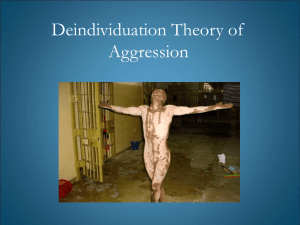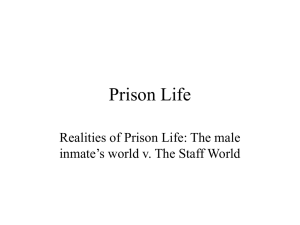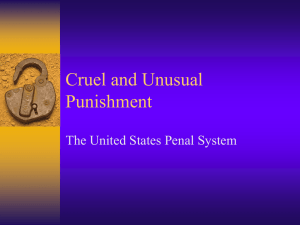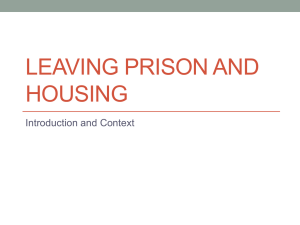DEINDIVIDUATION..research.
advertisement
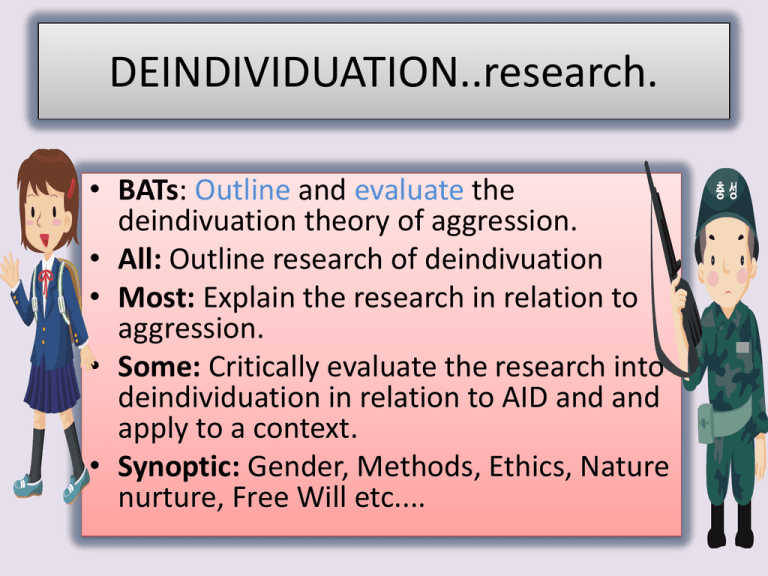
DEINDIVIDUATION..research. • BATs: Outline and evaluate the deindivuation theory of aggression. • All: Outline research of deindivuation • Most: Explain the research in relation to aggression. • Some: Critically evaluate the research into deindividuation in relation to AID and and apply to a context. • Synoptic: Gender, Methods, Ethics, Nature nurture, Free Will etc.... Origins of the theory....... • LeBon(1995)individuals behaviour change in the presence of large crowds, he described individuals in a crowd: ‘descends several rungs of the ladder of civilisation’ • A number of psychological factors involved the most important being: • Anonymity (It breeds a ‘collective mindset’) Zimbardo (1970/73) • Built upon LeBon’s original idea and went onto describe deindividuation as more than anonymity, there are other important factors. • Increased Arousal • Reduced Responsibility • Sensory Overload • Altered consciousness (drug/alcohol) Diener (1980) • Individuals act in well scripted ways and do so without conscious awareness. • They only become aware when being evaluated by others or if their behaviour does not follow a script. • Thus suggesting: • Crowds block an individuals capacity for self awareness and therefore become deindividuated but do not discount the effect of social arousal. Prentice Dunn & Rogers(1982) Public self awareness • Concern about impression • Can be reduced by anonymity/ diffusion of responsibility. So...loss of public awareness leads to a loss of public standards of behaviour and lowers our inhibitions. Private self awareness • Own thoughts and feelings • Can be reduced by becoming so involved in an activity we forget ourselves. So...loss of private awareness leads to a loss of internal standards & over reliance on environmental cues. Anonymous group behaviour ensures a reduced capability to engage in rational thinking. Fans become so involved in game that they are no longer self aware An example of reduced private self awareness. A reliance upon others in environment to set the standards of how to act. Factors that interact to cause deindividuation (adapted from Myers 1998) Group presence and size Social arousal Physical anonymity Decreased self awareness Diffusion of responsibility Deindividuation Increased responsivity to situational cues (private self awareness) Loss of normal inhibitions (public self awarenss) 1.Trick or Treat (TOTS) Diener et al 1976) Place: Seattle USA Procedure: 27 women asked to give out sweets to 1000 trick or treaters. Half the children were asked for names and addresses, the other half were anonymous. Some children were on their own, while others were in a crowd. Whilst chatting to the children the women had to answer a phone call and left the children with strict instructions to only take one sweet each. Results of TOTS investigation????? Children more likely to steal in groups when they were anonymous Sample High ecological validity Sample Operationalisation of aggression 2. Anonymous Lab Coat (ALC) Study (Zimbardo, 1970) Place: USA Procedure: Women dressed in lab coats &hoods in order to render them anonymous. A control group wore their own clothes and had name tags. The women had to shock victims (Think Milgram!!!) Results of ALC Study.... • Pp’s had to shock a victim (confederate). The anonymous pp’s shocked for longer than the identifiable pp’s. • Thus it can be concluded that..... Anonymity would appear to contribute to aggressive behaviour. Ku Klux Klan effect – suggested that there was an association with the KKK, this may have affected the amount of shocks given. Unethical – informed consent/protection from harm. given. Sample was just women – may be different for men. 3.The costume Experiment(CE) (Johnson & Downing,1979). • Pps made anonymous by wearing masks and overalls, similar to KKK or nurses. • Compared to control group Pps shocked more when dressed as KKK, but they shocked less when dressed as nurses. Not anonymity Artificial situation 3.The costume Experiment(CE) (Johnson & Downing,1979). 8 7 Shock level 6 5 4 Shock level 3 2 1 0 Identifiable Hoods and coats Graph illustrating results from the costume experiment. Nurses uniform Is deindividuation ever desirable? • Deindividuated can be both desirable and undesirable depending on the circumstances (Spivey & Prentice-Dunn, 1990; Johnson & Downing, 1979). • An interesting study by Spivey & Prentice-Dunn (1990) found that deindividuation could lead to either pro-social or anti-social behaviour depending on situational factors. • When pro-social environmental cues were present (such as a pro-social model) deindividuated subjects were more likely to behave altruistically. • Deindividuated subjects performed significantly more altruistic acts (gave money) and significantly less antisocial acts (electric shocks) compared to other people when in the presence of a pro-social model. 4. Darkened Room Arousal (DRAS) Gergen et al (1973) • The researchers discovered deindividuation enhanced affectionate behaviour. • Couples who were deindividuated using a dark chamber displayed significantly more affectionate behaviour such as touching and caressing in comparison to individuated couples in a light chamber. • These results imply that deindividuation may be helpful in intimate relationship development. Low ecological Validity. Evidence against deindividuation theory of aggression. Psychology in action......dating in the dark. • http://www.youtube.com/watch?v=K5DC692b 0y8&feature=related What would you do if you could remain anonymous? AO2/AO3 = Evaluation of deindividuation. Experimental support Other theories Instinct theory, Biological theories & drive theories. Recent analysis Norm based analysis of collective behaviour is supported Does not always lead to aggression Can result in pro social beahviour too, think natural disasters, anti social situations where individuals have not acted with indifference or no action!!!! Analysis of football supporters behaviour Ingham (1978) football supporters follow ritualised rules of behaviour in the terraces, acts of violence are not always the result of mob rule. Importation Model • This theory suggests prisoners bring their own set of rules and social histories, this subsequently alters their behaviour in prison (Irwin cressey,1962). • Their behaviour is not unique to prison, they would have acted this behaviour out in the wider society prior to be confined to prison. • They simply bring in a ‘here's one I made earlier’ attitude to prison. Importation cont… • Irwin went on to suggest it was wrong to simply focus upon ‘inmate culture’ and that it was necessary to examine how it is influenced by elements and experiences outside. • Such factors that have been known to affect inmates are: • Alcohol addiction • Race • Age • Employment record • Education • Previous criminal activity. What research have we to support these claims? • Mills et al (1998) surveyed 202 inmates using the Alcohol dependence Scale (ADS)...high levels of serious institutional misconduct were associated with the severe levels of alcohol. • Kane & Janus (1981) suggested that greater periods of unemployment and previous criminal activity also had a influencing impact on behaviour. • Evidence from US prisons show that non-whites & younger inmates far more likely to be aggressive in prison... • Reason: The groups are more likely to be disenfranchised & separated from mainstream societies norms & values that promote pro social methods of meeting basic needs & solving interpersonal conflict. • The underlying assumption being sub cultural forces have been influenced them to be aggressive in different contexts including their homes, areas where they live &….eventually prison. Identified different prisoner sub-cultures & three different categories….. Irwin & Cressey (1962) 2. Convict Subculture. 1.Criminal/thief culture. Inmates who have been raised in the prison system Follow norms from They seek power & information over the system. within their culture The primary reference group is fellow convicts. i.e. Not betraying one another. These prisoners are They refer to fellow inmates influenced by as their deprivation prior to imprisonment & these values primary reference group. are imported from outside (Blomberg & Lucken,2000) 3.Conventional/Straight subculture One time offenders, characterised as straights by Irwin & Cressey (1962) Not part of criminal subculture, they usually reject other subcultures & Identify with prison guards and staff. They do not tend to be aggressive. Situational models • The prison itself also brings about aggression, it cannot all be dispositional. • Situational factors must play a part: • Organisational: leadership,management,policies & procedures • Physical: Security level, level of available resources. • Staff characteristics: gender, level of experience, relationship with prisoners. • This can be demonstrated in the Deprivation Model. Deprivation model • Sykes (1958) outlined the pains of imprisonment that inmates experienced during their sentence. The origin of prison subculture emanates from within not outside the institute. • 5x deprivations arise from ‘the indignities degradations suffered by becoming an inmate’ (Massey,1986) are as follows: Deprivation model • Deprivation of liberty: This informs the prisoner they are not a trusted person who can live free. They feel morally rejected by society and there loss of liberty is further emphasised by the use of numbers and uniforms. Prisoners often have to obtain permission to eat/sleep shower etc (Blomberg & Lucken,2000). • Deprivation of autonomy: They have no power and very few choices, this leads to a feeling of almost helplessness among inmates, this can lead to frustration and aggression. Thus upon release they cannot think for themselves. • Deprivation of goods: deprived of goods and commodities, that they would expect to experience if they were not in prison. Brings about a sense of failure to most serving prison time (Sykes,1958). • Deprivation of heterosexual relationships: Important part of self identity, denial reduces men's sense of worth. In addition the greater opportunity for homosexual behaviour in prison may lead to anxieties for prisoners. • Deprivation of security: Prisoners report fear for their safety even though the institutes themselves are secure. They describe fellow inmates as aggressive and this leads to a heightened sense of physical threat. DEINDIVIDUATION..research. • BATs: Outline and evaluate the deindivuation theory of aggression. • All: Outline research of deindivuation (E) • Most: Explain the research in relation to aggression.(C) • Some: Critically evaluate the research into deindividuation in relation to AID and and apply to a context. (A) • Synoptic: Gender, Methods, Ethics, Nature nurture, Free Will etc.... Overall conclusion…. • All these deprivations lead to increased stress for prisoners. As a consequence of suffering some inmates react aggressively • (a) To gain control over social order imposed upon them. • (b) Reduce stress. • So is that it????????? The answer in short is no……… Other situational models….. The popcorn Model (Folger & Skarlicki,1995) 1 Individual is like first piece of corn to pop when the pan is hot. 2 Suggests that the environment ‘heats’ prisoners up So we need to sort out prison = reduction in violence. Evaluation of situational models. Constant levels of prisoner stress: Does not explain why riots sometimes explode out of nowhere, more recent research has focused upon relative rather than absolute deprivation(Colvin,1992) Research support: Richards (2007) inmate v inmate and inmate v staff assaults with 900 US prisons had higher than average rates whist some were lower suggest individual characteristics of prison play a part. Conflicting findings on crowding in prisons empirical findings do not seem to support the hypothesis. Unexplained motives Light (1991) developed a set of categories to describe the different settings in which prisoners assault prison officers. 1.unexplained- over 25% had no motive. Female aggression in prisons. Females offenders develop strong bonds with other members of their social groups rather than identify with prison subculture, therefore may be different to men.
